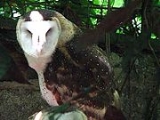
Philippine Scops Owl
Encyclopedia
The Philippine Scops Owl (Otus megalotis) is a common owl
, endemic
to the Philippines
, belonging to the family of the typical owls Strigidae. It is one of the sixteen owl species in the Philippines.
This small owl grows to a length of 20 cm (7.9 in) and a body mass of 180–310 g (6.3–10.9 oz). Their big forward-facing eyes are dark with an orange-red rim. Their crown, ear tufts and feathers are dark brown, with dark streaks above. The facial disk has a dark rim. The forehead has a whitish pale color. They have big erect ears, as their name "megalotis" indicates.
The Philippine Scops Owl lives alone or in monogamous pairs. They breed throughout the year, resulting in 1-2 eggs.
They nest in trees holes of forests of the Philippine lowlands. They can equally be found in the pine forests of Luzon
.
It preys at night on insects.
Its hooting call sounds like "oik oik oik".
Owl
Owls are a group of birds that belong to the order Strigiformes, constituting 200 bird of prey species. Most are solitary and nocturnal, with some exceptions . Owls hunt mostly small mammals, insects, and other birds, although a few species specialize in hunting fish...
, endemic
Endemic (ecology)
Endemism is the ecological state of being unique to a defined geographic location, such as an island, nation or other defined zone, or habitat type; organisms that are indigenous to a place are not endemic to it if they are also found elsewhere. For example, all species of lemur are endemic to the...
to the Philippines
Philippines
The Philippines , officially known as the Republic of the Philippines , is a country in Southeast Asia in the western Pacific Ocean. To its north across the Luzon Strait lies Taiwan. West across the South China Sea sits Vietnam...
, belonging to the family of the typical owls Strigidae. It is one of the sixteen owl species in the Philippines.
This small owl grows to a length of 20 cm (7.9 in) and a body mass of 180–310 g (6.3–10.9 oz). Their big forward-facing eyes are dark with an orange-red rim. Their crown, ear tufts and feathers are dark brown, with dark streaks above. The facial disk has a dark rim. The forehead has a whitish pale color. They have big erect ears, as their name "megalotis" indicates.
The Philippine Scops Owl lives alone or in monogamous pairs. They breed throughout the year, resulting in 1-2 eggs.
They nest in trees holes of forests of the Philippine lowlands. They can equally be found in the pine forests of Luzon
Luzon
Luzon is the largest island in the Philippines. It is located in the northernmost region of the archipelago, and is also the name for one of the three primary island groups in the country centered on the Island of Luzon...
.
It preys at night on insects.
Its hooting call sounds like "oik oik oik".

